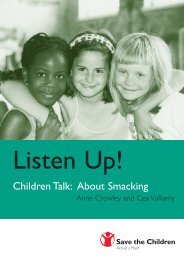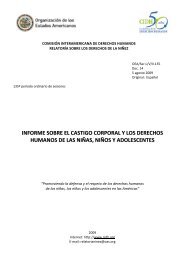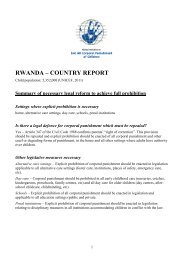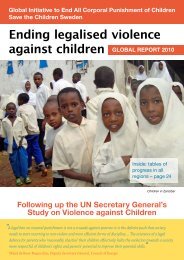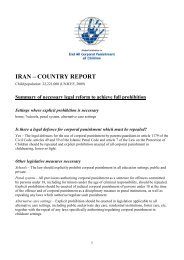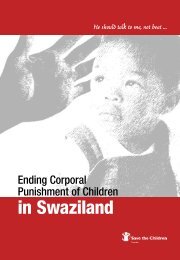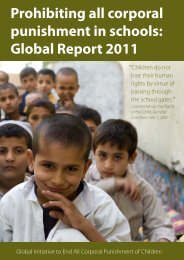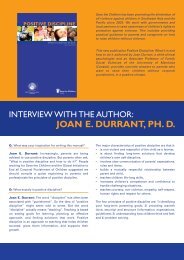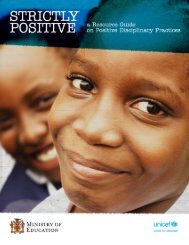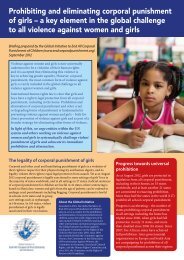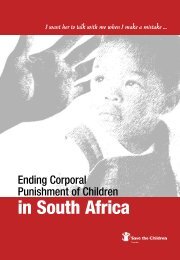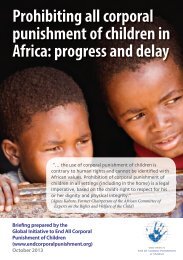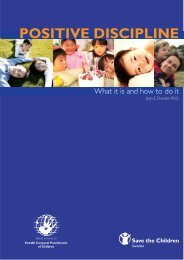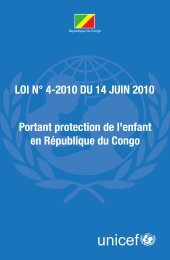Prohibiting corporal punishment of children in the Caribbean ...
Prohibiting corporal punishment of children in the Caribbean ...
Prohibiting corporal punishment of children in the Caribbean ...
Create successful ePaper yourself
Turn your PDF publications into a flip-book with our unique Google optimized e-Paper software.
used to resolve conflicts with <strong>children</strong> <strong>in</strong> <strong>the</strong> home were push<strong>in</strong>g, grabb<strong>in</strong>g and slapp<strong>in</strong>g <strong>children</strong> (experienced by 86% <strong>of</strong><strong>children</strong>) or beat<strong>in</strong>g <strong>the</strong>m with an object (84.2%). 7 In a later study, also <strong>in</strong> Jamaica, <strong>children</strong> described be<strong>in</strong>g beaten withobjects such as belts, rulers, garden hoses and boards, 8 and <strong>in</strong> a 2004 study <strong>in</strong>volv<strong>in</strong>g 203 parents <strong>of</strong> 6 year olds, 46.6% statedthat physical assault was <strong>the</strong> most commonly used “discipl<strong>in</strong>ary method” <strong>in</strong> <strong>the</strong>ir homes. Of those report<strong>in</strong>g physical assault31.1% reported spank<strong>in</strong>g and 13% beat<strong>in</strong>g with an object; o<strong>the</strong>r physical assaults <strong>in</strong>cluded p<strong>in</strong>ch<strong>in</strong>g <strong>children</strong>, shak<strong>in</strong>g <strong>the</strong>mand ty<strong>in</strong>g <strong>the</strong>ir hands. 9A 2010 study <strong>in</strong>volv<strong>in</strong>g 545 high school students aged 11-17 <strong>in</strong> Curaçao found that 37.4% had been badly shaken, squeezedhard, thrown aga<strong>in</strong>st a wall or to <strong>the</strong> ground, grabbed by <strong>the</strong> throat, beaten with a hard object, beaten <strong>in</strong> <strong>the</strong> face or attackedwith a hot or sharp object or a weapon by <strong>the</strong>irmo<strong>the</strong>r, fa<strong>the</strong>r or ano<strong>the</strong>r caregiver. Nearly one <strong>in</strong>five (19.6%) had experienced this <strong>in</strong> <strong>the</strong> past year. 10Children also experience <strong>corporal</strong> <strong>punishment</strong><strong>in</strong> schools and o<strong>the</strong>r <strong>in</strong>stitutions. Research <strong>in</strong> 2008<strong>in</strong> Haiti found that despite prohibition, <strong>corporal</strong><strong>punishment</strong> <strong>in</strong> schools was commonly reported,<strong>in</strong>clud<strong>in</strong>g whipp<strong>in</strong>g <strong>children</strong>, beat<strong>in</strong>g <strong>the</strong>m wi<strong>the</strong>lectric cables, and forc<strong>in</strong>g <strong>children</strong> to kneel <strong>in</strong> <strong>the</strong>sun. 11 In Jamaica, a study reported <strong>in</strong> 2007 foundthat one <strong>in</strong> four primary teachers admitted t<strong>of</strong>logg<strong>in</strong>g students <strong>of</strong>ten and one <strong>in</strong> three to p<strong>in</strong>ch<strong>in</strong>gand thump<strong>in</strong>g <strong>the</strong>m 12 and a 2004 study found that86.2% <strong>of</strong> <strong>children</strong> had experienced verbal aggressionor physical violence from a teacher, with <strong>in</strong>cidentsoccurr<strong>in</strong>g daily for some <strong>children</strong>. 13 In Guyana,survey results announced <strong>in</strong> 2007 showed that53% <strong>of</strong> schools used <strong>corporal</strong> <strong>punishment</strong>, 14 whileano<strong>the</strong>r survey found that a similar proportion(55%) <strong>of</strong> <strong>the</strong> twenty residential care <strong>in</strong>stitutions for<strong>children</strong> allowed beat<strong>in</strong>g as a <strong>punishment</strong> 15 and overa quarter (27%) <strong>of</strong> <strong>children</strong> <strong>in</strong> <strong>the</strong> <strong>children</strong>’s homesvisited <strong>in</strong> a 2004 study reported be<strong>in</strong>g physically hurtby a caregiver <strong>in</strong> <strong>the</strong> home. 16 In a focus group withtwenty <strong>children</strong> aged 10-18 years, liv<strong>in</strong>g <strong>in</strong> <strong>children</strong>’shomes and “places <strong>of</strong> safety” <strong>in</strong> Jamaica, a commonthread that ran through <strong>the</strong>ir conversations was<strong>the</strong> beat<strong>in</strong>gs given by Housemo<strong>the</strong>rs and “Aunties”.Corporal <strong>punishment</strong> was also raised as a concern <strong>in</strong>a focus group with workers for NGOs, and <strong>in</strong> writtensubmissions from members <strong>of</strong> <strong>the</strong> public. 17Child Fur<strong>the</strong>r helpl<strong>in</strong>e resources dataChild Helpl<strong>in</strong>e International (CHI), <strong>the</strong> global member network<strong>of</strong> child helpl<strong>in</strong>es, has produced a follow-up report to <strong>the</strong>2006 UN Secretary General’s Study on Violence Aga<strong>in</strong>stChildren every year s<strong>in</strong>ce 2007. The reports are based on dataga<strong>the</strong>red from some <strong>of</strong> CHI’s 133 member helpl<strong>in</strong>es, <strong>in</strong>clud<strong>in</strong>g<strong>in</strong>formation about <strong>children</strong>’s calls to helpl<strong>in</strong>es about violence.The 2011 report <strong>in</strong>cluded data from child helpl<strong>in</strong>es <strong>in</strong> Aruba,Curaçao, St Maarten, Sur<strong>in</strong>ame and Tr<strong>in</strong>idad and Tobago. InSur<strong>in</strong>ame alone, 265 calls about physical abuse were receiveddur<strong>in</strong>g 2010. Across <strong>the</strong> Americas and <strong>Caribbean</strong>, one <strong>in</strong>three calls to child helpl<strong>in</strong>es about physical abuse concerned<strong>corporal</strong> <strong>punishment</strong> by teachers and <strong>in</strong> over 40% <strong>of</strong> cases,parents were <strong>the</strong> perpetrators.Information from child helpl<strong>in</strong>escan help to make <strong>children</strong>’s experience visible. However, notall <strong>children</strong> report <strong>the</strong> violence <strong>the</strong>y experience, and <strong>the</strong> socialacceptance <strong>of</strong> <strong>corporal</strong> <strong>punishment</strong> <strong>in</strong> childrear<strong>in</strong>g means thatit may not be perceived by <strong>children</strong> and adults as “violence”or “abuse”. The reality <strong>of</strong> <strong>children</strong>’s experiences <strong>of</strong> punitiveviolence at home, at school and elsewhere is certa<strong>in</strong>ly far worsethan <strong>the</strong>se statistics can show.Child helpl<strong>in</strong>es agree on <strong>the</strong> importance <strong>of</strong> combatt<strong>in</strong>g<strong>corporal</strong> <strong>punishment</strong>: <strong>in</strong> <strong>the</strong> 2010 CHI report, more than threequarters <strong>of</strong> respond<strong>in</strong>g child helpl<strong>in</strong>es <strong>in</strong>dicated that <strong>corporal</strong><strong>punishment</strong> by parents was common, and 72% said that <strong>the</strong>ywere implement<strong>in</strong>g a project to prevent <strong>corporal</strong> <strong>punishment</strong>.References:Child Helpl<strong>in</strong>e International (2011), Violence Aga<strong>in</strong>st Children: Child helpl<strong>in</strong>e dataon abuse and violence, Amsterdam: Child Helpl<strong>in</strong>e InternationalChild Helpl<strong>in</strong>e International (2010), Violence Aga<strong>in</strong>st Children: Fourth ChildHelpl<strong>in</strong>e International Report, Amsterdam: Child Helpl<strong>in</strong>e International7 Samms-Vaughan, M. et al (2004), Jamaican Children’s Experiences <strong>of</strong> Corporal Punishment at Home and School, University <strong>of</strong> <strong>the</strong> West Indies/M<strong>in</strong>istry<strong>of</strong> Health/University <strong>of</strong> Missouri-Columbia8 Brown, J. & Johnson, S. (2008), “Childrear<strong>in</strong>g and child participation <strong>in</strong> Jamaican families”, International Journal <strong>of</strong> Early Years Education, 16(1), 31-409 Samms-Vaughan, M., Williams, S. & Brown, J. (2005), “Discipl<strong>in</strong>ary Practices among parents <strong>of</strong> six-year-olds <strong>in</strong> Jamaica”, Journal <strong>of</strong> <strong>the</strong> Children’s IssuesCoalition, 1, 58-7010 Kle<strong>in</strong>, K. (2010), De prevalentie van k<strong>in</strong>dermishandel<strong>in</strong>g onder middelbare scholieren op Curaçao en de visie van huisartsen op de signaler<strong>in</strong>g aldaar,Universitair Medisch Centrum Gron<strong>in</strong>gen11 Amnesty International (2008), Safe Schools: Every girl’s right, London: Amnesty International Publications12 Reported <strong>in</strong> Jamaica Gleaner Onl<strong>in</strong>e, 21 March 200713 See note 714 Reported <strong>in</strong> Stabroek News, 8 June 200715 M<strong>in</strong>istry <strong>of</strong> Labour, Human Services and Social Security (2006), Assessment <strong>of</strong> procedural and physical standards <strong>in</strong> <strong>children</strong>’s residential care<strong>in</strong>stitutions <strong>in</strong> Guyana16 See note 617 Keat<strong>in</strong>g, S. (2003), A Review <strong>of</strong> Children’s Homes, www.jamaicansforjustice.org/docs/Keat<strong>in</strong>g Report.pdf16 <strong>Prohibit<strong>in</strong>g</strong> <strong>corporal</strong> <strong>punishment</strong> <strong>of</strong> <strong>children</strong> <strong>in</strong> <strong>the</strong> <strong>Caribbean</strong>:



